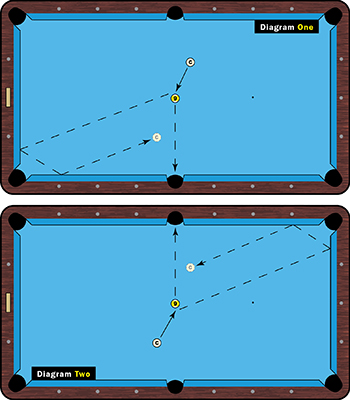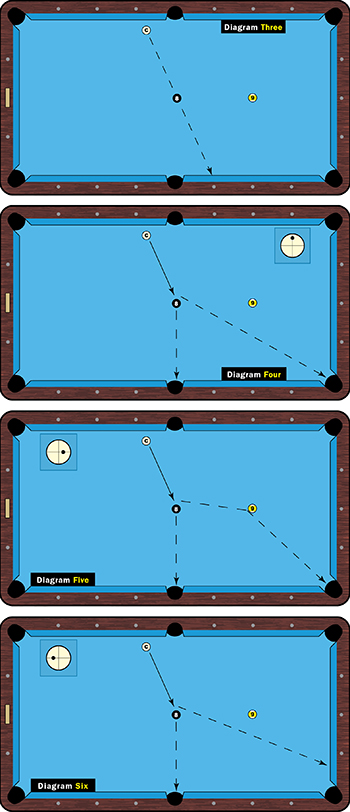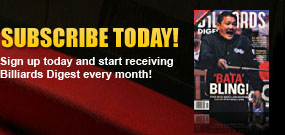One-ball drill; and never scratch again!
Here is a two-for-one lesson! These are simple exercises, but they are very effective for all amateur level players. And they are two of my favorites.
The first is the best single-ball drill there is!

What I like about this drill is that it allows me to get into a good rhythm, good tempo and, most of all, get a good handle on the table speed and feel for the rails.
This drill may look easy, but itís not. You need to be careful and focus. I usually do this drill when I have new cloth put on my table to get the speed down, see how the rails are reacting and using one or two rails to leave the proper angles.
The rules of this drill are that the cue ball must contact at least one rail. Play for position on the same ball (reset the object ball after each shot), rotating side pockets (Diagrams One and Two). The goal, of course, is to score as many points as you can. And, as always, your goal each time is to try to beat your previous score.
And here is a bonus tip. Follow my advice and you will never again scratch on this type of shot!
Diagram Three shows how the balls line up ó the cue ball just a few inches off the rail and a diamond up from the side pocket, and the line through the 8 ball runs to the first diamond below the side pocket.

I see so many amateurs play this shot with follow over and over again, using slow to medium speed (Diagram Four). And they scratch in the corner pocket more often than not. The only way to avoid the scratch if youíre using follow is with a lot of speed to throw the cue ball wider and go four rails around the table. Thatís a dangerous path. Iíd only play it this way if the cue ball was frozen to the rail. It would be your only choice.
I also see players elevate the butt end of their cue when theyíre close to the rail, aiming down on the cue ball and using a punch or punch draw stroke. With this approach there is a decent chance of kissing the 9 ball and scratching in either corner (Diagram Five). And even if you donít scratch, youíre likely to kiss the 9 into a bad position for your next shot.
The safest way to play this shot is to only slightly elevate your cue. Using a nice loose grip, hit the cue ball in the middle with no more than medium speed. This will make the cue ball grab nicely from the 8 ball and throw the cue ball just enough to avoid the scratch every time (Diagram Four). If youíre feeling really confident, you can play this with a touch of right English to get it further up the side rail, or with left English to straighten the cue ball off the short rail. Under pressure, though, keep it simple. Center ball, nice and easy with enough speed to land straight on the 9 ball. I donít even care if I land on the rail because Iíve practice this shot off the rail a million times and shoot it with confidence. Take your medicine and stay at the table. Donít be greedy.
This is a cool shot to have in your locker and you will be able to apply it from different spots on the table.
Another tip whenever youíre aiming down on the cue ball is to make sure you find your line before you get down on the shot. Make sure to keep your eye on the cue ball, not the object ball. Hitting the cue ball in the exact spot you want is vital.





